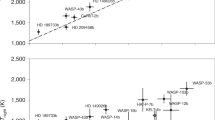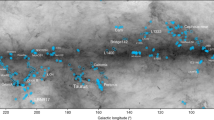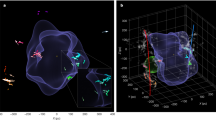Abstract
Giant convective cells have been predicted1 to exist in the Sun. Such cells should span the entire zone unstable to convective motions — now known to cover the outer 29 per cent of the Sun's radius2 — and could be dredging up the magnetic flux that is thought to be the source of solar activity (sunspots). Several studies3,4,5 have failed to detect these giant cells, although there have been hints6,7,8,9 of their existence. We have detected long-lived velocity cells, which we identify as the elusive giant convective cells, extending over 40–50 degrees of longitude but less than 10 degrees of latitude. The large aspect ratio (>4) is surprising (although predicted by one model10) and may be a consequence of the Sun's differential rotation, whereby features with a larger extent in latitude are broken up by rotational shear.
This is a preview of subscription content, access via your institution
Access options
Subscribe to this journal
Receive 51 print issues and online access
$199.00 per year
only $3.90 per issue
Buy this article
- Purchase on Springer Link
- Instant access to full article PDF
Prices may be subject to local taxes which are calculated during checkout



Similar content being viewed by others
References
Simon, G. W. & Weiss, N. O. Supergranules and the hydrogen convection zone. Z. Astrophys. 69, 435–450 (1968).
Christensen-Dalsgaard, J., Gough, D. O. & Thompson, M. J. The depth of the solar convection zone. Astrophys. J. 378, 413–437 (1991).
LaBonte, B. J., Howard, R. & Gilman, P. A. An improved search for large-scale convection cells in the solar atmosphere. Astrophys. J. 250, 796–798 (1981).
Snodgrass, H. B. & Howard, R. Limits on photospheric Doppler signatures for solar giant cells. Astrophys. J. 284, 848–855 (1984).
Chiang, W.-H., Petro, L. D. & Foukal, P. V. Aphotometric search for solar giant convection cells. Sol. Phys. 110, 129–138 (1987).
Cram, L. E., Durney, B. R. & Guenther, D. B. Preliminary observations of velocity fields at the solar poles. Astrophys. J. 267, 442–454 (1983).
Hathaway, D. H. et al. GONG observations of solar surface flows. Science 272, 1306–1309 (1996).
Simon, G. W. & Strous, L. H. Supergranular evolution, solar rotation, and a search for giant cells. Bull. Am. Astron. Soc. 29, 1402 (1997).
Ulrich, R. K. Large scale convection and the solar radius.In New Eyes to See Inside the Sun and Stars(eds Deubner, F.-L., Christnsen-Dalsgaard, J. & Kurtz, D. W.) (Proc. IAU Symp. 185, Kluwer, in the press).
Snodgrass, H. B. & Wilson, P. R. Solar torsional oscillations as a signature of giant cells. Nature 328, 696–699 (1987).
Brown, T. M. & Gilman, P. A. Techniques for detecting giant cells using spatially resolved solar velocity data. Astrophys. J. 286, 804–809 (1984).
Scherrer, P. H. et al. The solar oscillations investigation — Michelson Doppler imager. Sol. Phys. 162, 129–188 (1995).
Scherrer, P. H., Bogart, R., Hoeksema, J. T. & Yoshimura, H. in Seismology of the Sun and Distant Stars (ed. Gough, D. O.) 93–102 (Reidel, Dordrecht, (1986)).
Gilman, P. A. Nonlinear boussinesq convective model for large scale solar circulations. Sol. Phys. 27, 3–26 (1972).
Duvall, T. L. J, Harvey, J. W. & Pomerantz, M. A. Latitude and depth variation of solar rotation. Nature 321, 500–501 (1986).
Schou, J. et al. Helioseismic studies with SOI-MDI of differential rotation in the solar envelope. Astrophys. J.(in the press).
Nordlund, & & Aring;Dravins, D. Stellar granulation, III. Hydrodynamic model atmosheres. Astron. Astrophys. 228, 155–183 (1990).
Kim, Y.-C., Fox, P. A., Sofia, S. & Demarque, P. Modeling of shallow and inefficient convection in the outer layers of the sun using realistic physics. Astrophys. J. 442, 422–433 (1995).
Freytag, B., Ludwig, H.-G. & Steffen, M. Hydrodynamical models of stellar convection; the role of overshoot in DA white dwarfs, A-type stars, and the sun. Astron. Astrophys. 313, 497–516 (1996).
Bai, T. Distribution of flares on the sun during 1955–1985; “hot spots” (active zones) lasting for 30 years. Astrophys. J. 328, 860–878 (1988).
Duvall, T. L. J, D'Silva, S., Jefferies, S. M. & Harvey, J. W. Downflow under sunspots detected by helioseismic tomography. Nature 379, 235–237 (1996).
Kosovichev, A. G. Tomographic imaging of the sun's interior. Astrophys. J. 461, L55–L57 (1996).
Giles, P. M. et al. Asubsurface flow of material from the sun's equator to its poles. Nature 390, 52–54 (1997).
Acknowledgements
T.L.D. thanks P. Scherrer and the SOI group at Stanford for their hospitality during this work and for the use of their computing faciities, supported by NASA. SOHO is a mission of international cooperation between ESA and NASA. This work was supported in part by the Solar Physics Branch of the Space Physics Division of NASA.
Author information
Authors and Affiliations
Corresponding author
Rights and permissions
About this article
Cite this article
Beck, J., Duvall, T. & Scherrer, P. Long-lived giant cells detected at the surface of the Sun. Nature 394, 653–655 (1998). https://doi.org/10.1038/29245
Received:
Accepted:
Issue Date:
DOI: https://doi.org/10.1038/29245
This article is cited by
-
Identification of large-scale cellular structures on the Sun based on the SDO and PSPT data
Astrophysics and Space Science (2015)
-
Recent Advances on Solar Global Magnetism and Variability
Space Science Reviews (2015)
-
Probe spots enormous convection currents on the Sun
Nature (2013)
-
Comparisons of Supergranule Characteristics During the Solar Minima of Cycles 22/23 and 23/24
Solar Physics (2011)
-
Recent Progress and Future Prospects in Solar Physics, and Their Relevance for Planet Earth
Surveys in Geophysics (2004)
Comments
By submitting a comment you agree to abide by our Terms and Community Guidelines. If you find something abusive or that does not comply with our terms or guidelines please flag it as inappropriate.



